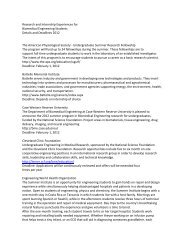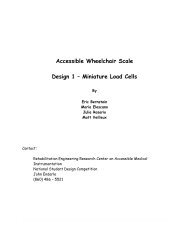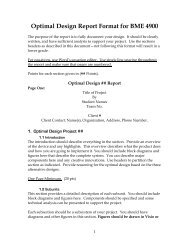Business Proposal - University of Connecticut
Business Proposal - University of Connecticut
Business Proposal - University of Connecticut
You also want an ePaper? Increase the reach of your titles
YUMPU automatically turns print PDFs into web optimized ePapers that Google loves.
<strong>Business</strong> <strong>Proposal</strong><br />
Revo Stationary Bike with “Generciser” Technology<br />
Team 12<br />
Drew Seils, Shane Tornifoglio<br />
Project for Entrepreneurial Senior Design<br />
Contact: Dr. John Bennett, Univ. <strong>of</strong> <strong>Connecticut</strong>,<br />
Engineering II Building Rm. 200C<br />
<strong>University</strong> <strong>of</strong> <strong>Connecticut</strong><br />
Storrs, CT 06269<br />
Phone: (860) 486-5003<br />
E-mail: jcbjr@engr.uconn.edu<br />
- 1 -
Table <strong>of</strong> Contents<br />
Executive Summary:………………………………………………………………. 3<br />
Introduction:……………………………………………………………………….. 4<br />
1.1 Background<br />
1.2 Purpose <strong>of</strong> the Project<br />
1.3.1 Previous Work Done by Others<br />
1.3.2 Patent search results<br />
Project Description:……………………………………………………………….. 6<br />
2.1 Objective<br />
2.2 Methods<br />
Budget:……………………………………………………………………………... 10<br />
3.1 Prototype Materials Budget<br />
3.2 Budget Analysis<br />
Conclusion:………………………………………………………………………… 12<br />
4.1 Project Summary<br />
4.2 Market Summary<br />
4.3 Budget Summary<br />
- 2 -
Executive Summary:<br />
This proposal’s purpose is to motivate upper management to fund the Revo stationary<br />
bike with “Generciser” technology project. The project is conveyed in its entirety throughout this<br />
proposal.<br />
The beginning <strong>of</strong> the proposal is the introduction which explains the basic ideas behind<br />
the Revo stationary bike, including the need for the Revo stationary bike and how it will fill that<br />
need. The introduction also includes a background section that discusses the client’s needs and<br />
requirements with detailed specifications. Following the background is a general purpose<br />
section. This section goes into detail about the need for the Revo stationary bike in society and<br />
how the Revo will fit those needs. This is followed by a section discussing previous work in the<br />
field. Research on current stationary bikes will be discussed in this section. Within this section<br />
the main competitors’ products as well as patents are brought up.<br />
The next area <strong>of</strong> the proposal is the project description. The project description provides<br />
an overview <strong>of</strong> the Revo stationary bike and all <strong>of</strong> its features. Upon completion <strong>of</strong> reading this<br />
section the upper management should know exactly what the Revo stationary bike has been<br />
designed to accomplish. All <strong>of</strong> the major components and creative innovations are briefly<br />
explained in this section.<br />
Following the project description is the methods section. In the methods section a more<br />
detailed overview <strong>of</strong> the project is explained. This section is an expansion <strong>of</strong> the project<br />
description. The design figures and block diagrams <strong>of</strong> the Revo stationary bike are included in<br />
this section to give the upper management a visual <strong>of</strong> the project. Each <strong>of</strong> the components is also<br />
included here in full detail giving the total description <strong>of</strong> the Revo stationary bike.<br />
The next area <strong>of</strong> the proposal is the budgeting section. This section contains the cost <strong>of</strong><br />
building the Revo stationary bike in as much detail as possible. At this time it provides a rough<br />
estimate for production. A comparison is made against other stationary bicycles on the market.<br />
For the purpose <strong>of</strong> this proposal, the price <strong>of</strong> the Revo stationary bike is scaled to be 35% <strong>of</strong> the<br />
prototype costs.<br />
- 3 -
The last section <strong>of</strong> the proposal is the conclusion. This is a brief summary <strong>of</strong> the Revo<br />
stationary bike, highlighting the important features that make this product unique. The<br />
conclusion also highlights points dealing with the market and budget issues.<br />
Introduction:<br />
1.1 Background<br />
Current stationary bike designs make it difficult for elderly users or patients recovering<br />
from hip complications to step their leg over the machine and sit on the bike. These people may<br />
also have difficulty standing up from the seated position once on the bike. Being able to use the<br />
stationary bike and utilize the zero impact workout decreases recovery time and increases the<br />
stability <strong>of</strong> the hips and knees. The adjustability <strong>of</strong> current stationary bikes is also limited, for<br />
example pedals are at a fixed height, displays and grips are also fixed.<br />
Stationary bikes also generate a great deal <strong>of</strong> power that goes unharnessed. Bikes will<br />
<strong>of</strong>ten use the power generated by the user to power the display board, but no further uses are<br />
implemented. This power has potential applications in space station technology. The power<br />
generated could be used to charge battery arrays or personal devices <strong>of</strong> astronauts who are using<br />
the device to maintain their muscular integrity in the micro-gravity environment.<br />
1.2 Purpose <strong>of</strong> the Project<br />
The project title is the Revo stationary bike and this machine serves three main purposes.<br />
The concept for the bike is a machine that makes it easier for disabled, elderly, or otherwise<br />
injured and recovering people to use a stationary bike. The second concept is a way for the bike<br />
to feed excess power generated by the user’s kinetic energy back into the grid via an AC outlet.<br />
This ties into the third purpose which would be to use this bike in space stations as a method to<br />
provide power in outer space either to recharge station battery arrays or small devices directly.<br />
By combining these three concepts a pr<strong>of</strong>itable product can be produced. However there<br />
will be numerous models <strong>of</strong> the product geared towards what the consumer is looking for. It can<br />
be said that a rehabilitation bike for someone recovering from hip surgery will certainly produce<br />
less power than one used by an avid cyclist. Therefore the rehabilitation bike will have a focus<br />
on rehabilitation and making the user comfortable to increase the rate <strong>of</strong> recovery and subsequent<br />
strength at the end <strong>of</strong> the recovery.<br />
- 4 -
A second model can be used for larger gyms that are looking to gain from their patrons<br />
work out regiments. By having a large number <strong>of</strong> Revo stationary bikes running at once, all <strong>of</strong><br />
the lighting in the gym could be powered, reducing the electric bill <strong>of</strong> the gym. If in fact there is<br />
enough power generated by the patrons to exceed the gyms power consumption, the gym could<br />
sell power back to the national power grid. This model will be marketed for sale to the average<br />
household. The concept would be to a have trendy stationary bike that can be used in a small<br />
space in a household which can provide a source <strong>of</strong> exercise as well as supplying power back<br />
into the household grid. This would follow in the wave <strong>of</strong> green energy options that are now<br />
entering the market.<br />
The third model which has recently come into possible action is the idea <strong>of</strong> using the<br />
Revo in outer space on space stations. Design changes may occur in materials used and overall<br />
size <strong>of</strong> the device. This idea must be explored further to see what would be required <strong>of</strong> the device<br />
and how to best meet those objectives.<br />
1.3.1 Previous Work Done by Others<br />
There are hundreds <strong>of</strong> stationary bikes out on the market. However, very few <strong>of</strong> these are<br />
specifically geared towards rehabilitation. The rehabilitation devices related sets <strong>of</strong> pedals that<br />
can be set on the floor in front <strong>of</strong> a chair. These small bike substitutes that are just the pedal unit<br />
have no displays and are difficult to change resistance settings to increase difficulty levels. They<br />
also have no programs to aide the user in creating an effective workout. One <strong>of</strong> the models is a<br />
hand cycle that comes with the pedal attachment.<br />
The Green Revolution Inc. © has developed some stationary bikes that generate power as<br />
one cycles, however on an individual workout basis the amount <strong>of</strong> power generated can light a<br />
light bulb for roughly an hour.<br />
http://www.switched.com/2008/11/12/green-stationary-bikes-generate-power-as-you-work-out/<br />
http://www.rehaboutlet.com/stationary_bikes.htm<br />
http://www.shop.com/rehab+STATIONARY+BIKEs?g=1&t=2&p=225173340&k=24<br />
- 5 -
1.3.2 Patent search results<br />
The biggest patent concern is the “Generciser” technology. This is an issue that must be<br />
discussed further with Eric Knight, who contributed the idea to the group.<br />
There are however some patents dealing with the basic designs <strong>of</strong> the stationary bike. The<br />
overall patent includes many other patents for the components <strong>of</strong> each part. The patent is very<br />
general and discusses the basic parts that make up a stationary bike such as the frame, display,<br />
pedals, and seat. Some <strong>of</strong> the companies with patents include Tonic Fitness Technolgy© and<br />
Brunswick Corporation©. Some <strong>of</strong> the other smaller patents include turning control devices for<br />
virtual stationary bikes, support frames for stationary bikes, and a centrifugal resistance device<br />
for stationary bicycles.<br />
http://www.patents.com/Stationary-bike/US6913560/en-US/<br />
http://www.google.com/patents?q=stationary+bike&btnG=Search+Patents<br />
Project Description:<br />
2.1 Objective<br />
The Revo stationary bike will be made <strong>of</strong> two components. The device is separated into<br />
components for easier assembly during manufacturing and increased customizability. The most<br />
important unit is the head unit. The head unit is where most <strong>of</strong> the major components <strong>of</strong> the bike<br />
will be housed. This unit contains the entire pedal assembly, gearing, and “Generciser”<br />
technology. The entire user interface also anchors into the top <strong>of</strong> the head unit. Further details as<br />
to what displays are shown and what program options are available are discussed further in the<br />
methods section.<br />
The second component <strong>of</strong> the Revo stationary bike is the rear unit. This part varies with<br />
each model. The main unit marketed for the average consumer household and gyms will be a<br />
simple seat for the user with horizontal and vertical adjustments to suit a wide range <strong>of</strong> body<br />
types. The second rear unit is for the rehabilitation model. This unit is motorized by a battery to<br />
assist patrons in maneuvering onto the bike to exercise. The details <strong>of</strong> the unit are further<br />
explained in the methods section.<br />
The goal <strong>of</strong> the Revo stationary bike is to use creative innovation to provide new services<br />
and features for stationary bikes that are currently not available. There are many types <strong>of</strong><br />
- 6 -
stationary bikes on the market each very similar to the next. There are very few stationary bikes<br />
that are used specifically for rehabilitation and even fewer that produce electricity to be used<br />
externally. By combining these two features into one product, the Revo stationary bike, will be<br />
very successful across a number <strong>of</strong> different markets.<br />
For a much smaller market, specifically NASA, the Revo stationary bike has the<br />
possibility to become a vital innovation in human powered space systems. NASA has shown<br />
interest in the product, but further discussion as to their specifications and requirements have not<br />
been established.<br />
2.2 Methods<br />
The most complex unit is the head unit, which will house the “Generciser” unit which<br />
gathers the excess energy and feeds it back into an AC outlet. The “Generciser” is ideally a<br />
small, inexpensive, power inverter that can be easily integrated into the design <strong>of</strong> the stationary<br />
bike. The benefit <strong>of</strong> using an AC outlet is that the Revo bike does not need a dedicated circuit to<br />
transmit its electrical output. Dedicated circuits are currently in use by gyms utilizing patron<br />
generated power and the Revo would eliminate the need for such circuits. This would eliminate<br />
the need for such systems and make it easier for existing gyms to integrate patron power into<br />
their systems without the excess cost <strong>of</strong> reconfiguring the electrical system <strong>of</strong> the building.<br />
The head unit will also house the pedal assembly and the display board. The lightweight<br />
pedals will have adjustable toe straps to help the user maintain firm contact with the pedals<br />
during the entire revolution. The toe straps would also help astronauts in the micro-gravity<br />
environment <strong>of</strong> space maintain contact with the pedals. The drive assembly will be chain driven<br />
utilizing a 36 tooth chainring on the right side <strong>of</strong> the pedal assembly. The chain will drive a 9-<br />
speed cassette. The placement <strong>of</strong> the chain on the cassette will be governed by a derailleur which<br />
is controlled by grip shifter on the hand rails. The main flywheel <strong>of</strong> the will be connected to a<br />
series <strong>of</strong> small dynamos which will gather power from the rotating wheel. The dynamos will<br />
provide a set level <strong>of</strong> resistance to the rotating wheel. The gearing allows the user to determine<br />
how much leverage they want to have in powering the rotating wheel. The higher the gear the<br />
user selects, the higher the resistance, the higher the speed <strong>of</strong> the wheel, and in turn the greater<br />
the amount <strong>of</strong> electricity generated.<br />
- 7 -
The generated power is first used to power the display board <strong>of</strong> the Revo bike. Any<br />
excess power that is not required for the display is used to either charge the battery in the rear<br />
rehabilitation unit or is sent to the “Generciser” where it is converted to AC power and sent out<br />
into the grid via an AC outlet.<br />
Figure 1: Preliminary Design Sketch <strong>of</strong> Head Unit with Display Board<br />
Since the machine is intended for rehabilitation purposes it should be able to operate at<br />
low revolutions per minute (RPM). Most conventional stationary bikes will pause the display<br />
board or turn <strong>of</strong>f the display when RPMs drop below 30 revolutions per minute. The display<br />
board will be powered by the rider. There will be a number <strong>of</strong> features on the display board<br />
including distance, speed, calories spent (total and per hour), output in watts (current and per<br />
hour), resistance level, heart rate, and workout time. The user will be able to input height and<br />
weight measurements to get more accurate caloric readings. Another display board object will be<br />
a small track made which will show user progress around a simulated 400 meter track. The<br />
display board will also have a port for charging iPods. While the iPod is attached, an LCD screen<br />
located in the center <strong>of</strong> the simulated track will act as a larger display for the iPod. This will<br />
allow the user to watch videos and cycle through music with ease during a workout. The display<br />
board will also have a standard headphone jack for audio when the user’s Ipod is in the port.<br />
Small speakers on the sides <strong>of</strong> the display board will play the audio from the user’s Ipod when<br />
the headphone jack is not in use. At the base <strong>of</strong> the display board will be two water bottle holders<br />
as well as small shelves for propping up magazines or books at different angles. Surrounding the<br />
- 8 -
display board will be handrails which will also house the heart rate sensors and the grip shifter<br />
for the resistance setting.<br />
Figure 2: Preliminary Design Sketch <strong>of</strong> Display Board and Hand Rails<br />
The second unit is the rehabilitation seat. One function will be to slide down and away<br />
from the machine to make it easier for users to reach the seat without stepping over the machine.<br />
In order to move away from the head unit the rear seat unit will slide away on a motorized track.<br />
The maximum distance will be between 2 and 3 feet, allowing the user to walk in front <strong>of</strong> the<br />
seat, sit down, and then slide themselves back up to the head unit. This would prove very<br />
beneficial for users who may usually need a walker to move around. The height <strong>of</strong> the seat unit<br />
will also be a motorized adjustment. It would be easier for a user to sit on and get <strong>of</strong>f a lower seat<br />
than a higher one that may be required to perform the exercise. This will all be controlled by a<br />
panel on the seat post for horizontal and vertical adjustments. Another function is to potentially<br />
aide the user in standing after exercising on the Revo. The seat, powered by a hydraulics<br />
anchored in the sliding track, will be able to raise the up at a forward angle. This will put the user<br />
in an upright and standing position with the handrails within easy reach for stabilization. This<br />
unit will be powered by a 12 volt battery that is housed in the head unit and recharged once the<br />
user is pedaling. The seat will mimic a typical bicycle saddle however a retractable back will be<br />
- 9 -
available to provide support for positions in which the rider is sitting at an angle greater than 90<br />
degrees with respect to a horizontal plane.<br />
The third unit is a conventional seat developed for gym and private use with no<br />
motorized support. The seat will have similar adjustability to the rehabilitation unit, allowing the<br />
user to move the seat forward, backward, and vertically. The adjustable back support could also<br />
be implemented in the conventional seat.<br />
Budget:<br />
3.1 Prototype Materials Budget<br />
Part: Quantity: Price USD:<br />
SRAM SX-5 Rear Derailleur - 8/9 spd 1 24.99<br />
Sram Shifter - X5 Grip Shifter Set – 9 spd 1 27.95<br />
2008 Sram 950 Cassette w/ 951 Chain Combo Kit 1 39.98<br />
Shimano Deore M525 Disc Rear Hub 1 29.99<br />
Sette Torx ST-27 Hollowtech II Bottom Bracket Tool 1 14.98<br />
Sette Torx ST-215CB Cotterless Crank Puller 1 6.98<br />
Truvativ Howitzer Team Bottom Bracket 2008 1 29.98<br />
Truvativ Blaze 3.1 Crankset 2008 1 49.98<br />
TKO BH-736HR 7 inch Headrest TFT LCD Monitor 1 82.99<br />
Griffin AirDock Docking Station - 6139-AIRDOCK 1 24.99<br />
Alloy 6061 Aluminum Material: Aluminum - Alloy 1 27.34<br />
6061 Length: 48 Width: 2.000 In. Thickness: 0.250 In.<br />
MSC #: 06957948<br />
Alloy 6063 Aluminum Wall Thickness: 1/8 Length: 72<br />
Width: 4 Material: Aluminum - Alloy 6063<br />
MSC #: 32001026<br />
(a) (b)<br />
Figure 3: Preliminary Design Sketch <strong>of</strong> Rehabilitation Rear Unit (a) and<br />
Conventional Rear Unit (b)<br />
- 10 -<br />
4 282.84
Alloy 6063 Aluminum Wall Thickness: 1/8 Length: 72<br />
Width: 2 Material: Aluminum - Alloy 6063<br />
MSC #: 32001000<br />
Acrylic - Clear Material: Acrylic Thickness: 0.125 In.<br />
Length: 48 Width: 48 Color: Clear<br />
MSC #: 63388953<br />
Alloy 6061 Aluminum Material: Aluminum - 6061-T6<br />
Outside Diameter: 2 Wall Thickness: 0.250 In. Inside<br />
Diameter: 1.500 In.<br />
MSC #: 36968261<br />
Display Board<br />
(Based on competitor models with electronics and<br />
casing)<br />
2 83.22<br />
2 169.78<br />
3 100.11<br />
1 500.00<br />
Test Pilot 200mm Ladder Strap 2 15.98<br />
Test Pilot Pump Buckle 2 13.98<br />
Sarfas Reactive Gel EX-2600 Exerciser Bike<br />
Seat/Saddle<br />
3.2 Budget Analysis<br />
General Purpose Motors - Three Phase TEFC Thermal<br />
Protection Rating: None Applications: General Purpose<br />
Motor Type: Three Phase Energy Efficient Type <strong>of</strong><br />
Enclosure: TEFC Horsepower: 1 Frequency Hz: 60<br />
MSC #: 04089918<br />
General Purpose Motors - Three Phase TEFC Thermal<br />
Protection Rating: None Applications: General Purpose<br />
Motor Type: Three Phase Energy Efficient Type <strong>of</strong><br />
Enclosure: TEFC Horsepower: 5 Frequency Hz: 60<br />
MSC #: 04088290<br />
20° Spur Gears Type: Spur Gear Diametral Pitch: 16<br />
Pitch Diameter: 3.000 In. Bore Diameter: 0.625 In., 5/8<br />
Number <strong>of</strong> Teeth: 48 Outside Diameter: 3.125 In.<br />
MSC #: 02274306<br />
2 89.90<br />
1 242.49<br />
1 371.45<br />
2 92.58<br />
M-Wave Alloy BMX 9/16-Inch Bike Pedals 2 15.28<br />
Bolts + Fasteners - 200.00<br />
Total: 2537.76<br />
The prototype estimate comes out to be $2,537.76 in material costs. The final product<br />
should be priced for 35 percent <strong>of</strong> the initial prototype cost, which places the selling price at<br />
$888.22. This is a very reasonable amount for such an innovative machine. This places the<br />
pricing <strong>of</strong> the final product with mediocre level stationary bikes, below that <strong>of</strong> many high end<br />
- 11 -
models with fewer capabilities. Models such as the Star Trac S-UBx Upright Bike have a MSRP<br />
<strong>of</strong> $2,595.00. The Life Fitness Club Series Upright LifeCycle Exercise Bike retails for<br />
$2,499.00. Neither <strong>of</strong> these models have features that can compete with the energy innovations<br />
<strong>of</strong> the Revo bike. One stationary bike that falls within the same price range as the Revo is the<br />
Kettler RT 307 Upright Stationary Exercise Bike which has a retail price <strong>of</strong> $649.00. The Kettler<br />
has displays total distance, time, speed, pulse. The Kettler also requires a 110 volt power source<br />
which makes it an inferior product to the conventional version <strong>of</strong> the Revo.<br />
Conclusion:<br />
4.1 Project Summary<br />
The Revo stationary bike is intended to serve two main purposes. The first being a<br />
stationary bike that is specifically designed for rehabilitation purposes. This is achieved by<br />
designing the rear unit to move away from the machine, allowing easier access for users and a<br />
higher level <strong>of</strong> adjustability. Having access to the zero-impact workout <strong>of</strong> the stationary bike is<br />
crucial for people with recovering from hip or knee injury or replacements. Elderly individuals<br />
would also benefit from zero-impact exercises.<br />
The second purpose <strong>of</strong> the Revo is to feed energy generated in excess by the user back<br />
into the electrical grid via an AC outlet. This has applications in large physical training facilities<br />
as well as in a private home environment. A gym could potentially power much <strong>of</strong> its facilities<br />
with the power generated by an array <strong>of</strong> Revo bikes. Another application <strong>of</strong> the energy<br />
capabilities <strong>of</strong> the Revo is in the space station. Astronauts could use a version <strong>of</strong> the Revo bike<br />
as part <strong>of</strong> a daily exercise regiment to maintain their muscular integrity. At the same time those<br />
astronauts would be generating electricity that can be used to power various devices on boards<br />
such as charging battery arrays or personal devices.<br />
4.2 Market Summary<br />
Due to the number <strong>of</strong> capabilities <strong>of</strong> the Revo stationary bike, it opens up a number <strong>of</strong><br />
possible markets. First <strong>of</strong> all, rehabilitation facilities would be interested in the device for its ease<br />
<strong>of</strong> use. For this same reason, the Revo could become a popular device among elderly users, who<br />
have a difficult time using other conventional stationary bikes.<br />
- 12 -
The energy potential would make the Revo a highly desired machine for physical training<br />
facilities looking increase their “Green” pr<strong>of</strong>ile while minimizing cost. With arrays <strong>of</strong> Revo<br />
cycles, gym could potentially pr<strong>of</strong>it from their patrons’ workout routines. Private home users<br />
would also find interest in the Revo for its trendy “Green” energy system. It is also user friendly<br />
with the Ipod features which will cooperate with today’s technology age.<br />
Another market potential is using versions <strong>of</strong> the Revo stationary bike as power<br />
generators in remote facilities such as in the space station. Having an easily renewable energy<br />
source is extremely important in the space station and even if the bike is used to charge small<br />
devices, it atleast takes some demand <strong>of</strong>f the battery arrays <strong>of</strong> the station.<br />
4.3 Budget Summary<br />
The budget takes into account the material cost in building the prototype Revo stationary<br />
bike. The rough estimate <strong>of</strong> the prototype cost is $2537.76. The price <strong>of</strong> the final product then<br />
calculates out to be around $888.22 which places the Revo stationary bike in the center <strong>of</strong> the<br />
price range for similar devices. Stationary bikes can be purchased for amounts ranging from<br />
$100 to $5000 and higher. As the prices rise, so do the number <strong>of</strong> features and capabilities <strong>of</strong><br />
each model. However, the Revo is able to incorporate a large number <strong>of</strong> functions and innovative<br />
features that as a device it is able to compete with very high end models while its pricing reflects<br />
that <strong>of</strong> a mediocre bike. The combination <strong>of</strong> these two entities gives the Revo a high potential for<br />
success.<br />
- 13 -

















